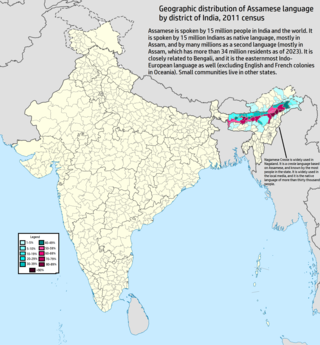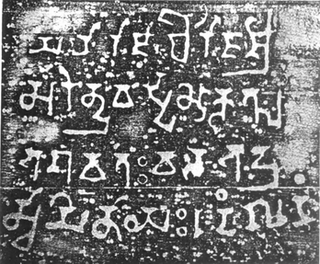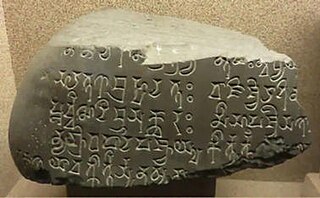
The Indo-Aryan languages are a branch of the Indo-Iranian languages in the Indo-European language family. As of the early 21st century, they have more than 800 million speakers, primarily concentrated in India, Pakistan, Sri Lanka, Bangladesh, Nepal and Maldives. Moreover, apart from the Indian subcontinent, large immigrant and expatriate Indo-Aryan–speaking communities live in Northwestern Europe, Western Asia, North America, the Caribbean, Southeast Africa, Polynesia and Australia, along with several million speakers of Romani languages primarily concentrated in Southeastern Europe. There are over 200 known Indo-Aryan languages.

Assamese or Asamiya is an Indo-Aryan language spoken mainly in the north-eastern Indian state of Assam, where it is an official language. It serves as a lingua franca of the wider region and has over 15 million native speakers according to Ethnologue.

Kamarupi Prakrit is the postulated Middle Indo-Aryan (MIA) Prakrit language used in ancient Kamarupa. This language is the historical ancestor of the Kamatapuri lects and the modern Assamese language; and can be dated prior to 1250 CE, when the proto-Kamta language, the parent of the Kamatapuri lects, began to develop. Though not substantially proven, the existence of the language that predated the Kamatapuri lects and modern Assamese is widely believed to be descended from it.

The Assamese alphabet is a writing system of the Assamese language and is a part of the Bengali-Assamese script. This script was also used in Assam and nearby regions for Sanskrit as well as other languages such as Bodo, Khasi, Mising, Jaintia etc. It evolved from Kamarupi script. The current form of the script has seen continuous development from the 5th-century Umachal/Nagajari-Khanikargaon rock inscriptions written in an eastern variety of the Gupta script, adopting significant traits from the Siddhaṃ script in the 7th century. By the 17th century three styles of Assamese alphabets could be identified that converged to the standard script following typesetting required for printing. The present standard is identical to the Bengali alphabet except for two letters, ৰ (ro) and ৱ (vo); and the letter ক্ষ (khya) has evolved into an individual consonant by itself with its own phonetic quality whereas in the Bengali alphabet it is a conjunct of two letters.

Buranjis are a class of historical chronicles and manuscripts associated with the Ahom kingdom written initially in Ahom Language and later in Assamese language as well. The Buranjis are an example of historical literature which is rare in India. They bear resemblance to Southeast Asian traditions of historical literature. The Buranjis are generally found in manuscript form, though a number of these manuscripts have been compiled and published, especially in the Assamese language.

Kamarupa, an early state during the Classical period on the Indian subcontinent, was the first historical kingdom of Assam.

The Varman dynasty (350–650) was the first historical dynasty of the Kamarupa kingdom. It was established by Pushyavarman, a contemporary of Samudragupta. The earlier Varmans were subordinates of the Gupta Empire, but as the power of the Guptas waned, Mahendravarman (470–494) performed two horse sacrifices and the status of Kamarupa as an independent state remained unimpaired. As per the Apsad Inscription of Adityasen, Susthivarman was defeated by Mahasengupta on the bank of Lauhitya. The first of the three Kamarupa dynasties, the Varmans were followed by the Mlechchha and then the Pala dynasties.

Since the Iron Age in India, the native languages of the Indian subcontinent are divided into various language families, of which the Indo-Aryan and the Dravidian are the most widely spoken. There are also many languages belonging to unrelated language families such as Munda and Tibeto-Burman, spoken by smaller groups.

Goalpariya is a group of Indo-Aryan dialects spoken in the Goalpara region of Assam, India. Along with Kamrupi, they form the western group of Assamese dialects. The North Bengali dialect is situated to its west, amidst a number of Tibeto-Burman speech communities. The basic characteristic of the Goalpariya is that it is a composite one into which words of different concerns and regions have been amalgamated. Deshi people speak this language and there are around 20 lakhs people.

The People of Assam inhabit a multi-ethnic, multi-linguistic and multi-religious society. They speak languages that belong to four main language groups: Tibeto-Burman, Indo-Aryan, Tai-Kadai, and Austroasiatic. The large number of ethnic and linguistic groups, the population composition, and the peopling process in the state has led to it being called an "India in miniature".
Though the precise Etymology of Assam, a state in India is unclear—there is general agreement that it is related to the Ahom people. Whatever the source of the English name, Assam is itself an anglicization.

The earliest Indo-Aryan migration to Assam is estimated to have occurred between the 2nd century BCE and 1st century CE—not earlier than 500 BCE. The earliest epigraphic record suggests that the Indo-Aryan migration began latest by the middle of the 4th century CE. They came from the Gangetic Plains into a region already inhabited by people who spoke Austroasiatic and Tibeto-Burman languages.

The Bengali–Assamese script, also known as Eastern Nagari, is a modern eastern Indic script that emerged from the Brahmi script. Gaudi script is considered the ancestor of the script. It is known as Bengali script among Bengali speakers, as Assamese script among Assamese speakers, and Eastern-Nāgarī is used in academic discourse.

Kamrupi dialects are a group of regional dialects of Assamese, spoken in the Kamrup region. It formerly enjoyed prestige status. It is one of two western dialect groups of the Assamese language, the other being Goalpariya. Kamrupi is heterogeneous with three subdialects— Barpetia dialect, Nalbariya dialect and Palasbaria dialect.

The Umachal rock inscription is one of the earliest epigraphic sources discovered in Assam. Dated to the 5th century, the rock description was discovered in the north-eastern slopes of the Nilachal Hills, near Guwahati city. The artifact is dated primarily on the basis of the identification of the named Surendravarman with Mahendravarman of the Varman dynasty. The script is in the Nagari variety of the Gupta script and the language is Sanskrit prose. Though the Nilachal Hills is known for the Kamakhya Temple, a shakta/tantra site, this temple was for Balabhadra, a god of the Vaishnavite pantheon.

The Nagajari-Khanikargaon rock inscription is a 5th-century land grant discovered in the Nagajari area of the Golaghat district. The artifact is fragmentary, with inscriptions in Sanskrit written in the eastern variety of the Brahmi script. In style, language, and script, the inscription is very similar to the Umachal and Barganga rock inscriptions. Additionally, since it betrays no influence of a local Prakrit, this inscription is often placed earlier than the Umachal rock inscription. It also indicates that Indo-Aryan culture had spread to the Golaghat region by the 5th century. It is also speculated that it might belong to a different dynasty unrelated to the Varmans of Kamarupa.

Kamarupi script was the script used in ancient Kamarupa from as early as 5th century to 13th century, from which the modern Assamese script eventually evolved. In the development of the Assamese script, this phase was followed by the medieval and then by the modern Assamese scripts.

Davaka was a kingdom of ancient Indian subcontinent, located in current central region of Assam state. The references to it comes from the 4th century Allahabad pillar inscription of Samudragupta, where it is mentioned as one of five frontier kingdoms of the Gupta Empire.
The Dubi copperplate inscription are the inscriptions of a grant issued by Bhaskaravarman of Kamarupa. This is the earliest of all copper plate grants issued by Kamarupa kings discovered so far. This was an issue after an earlier charter, issued by Bhutivarman, was destroyed. There are five copper plates in this collection, with seventy-six verses in Sanskrit, written in the eastern variety of North Indian alphabet prevalent in the sixth and seventh centuries. All six plates in this grant were first discovered around 1950 during digging near a Siva temple in Dubi village about three miles from the Pathsala railway station, Kamrup district, Assam; but the sixth plate was irrecoverably destroyed soon after discovery. These plates are currently in the Assam State Museum. This plate was issued before the Nidhanpur copperplate inscription, during the earlier part of Bhaskkaravarman's reign.

The Gaudi script, also known as the Proto-Bengali script or the Proto-Oriya script is an abugida in the Brahmic family of scripts. Gaudi script gradually developed into the Bengali-Assamese, Odia, and Tirhuta script.

















